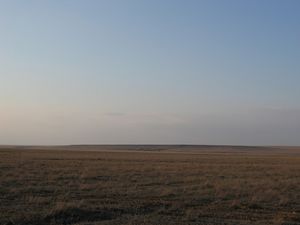السهوب القزاقية
| السهوب القزاقية Kazakh Steppe | |
|---|---|
 | |
 Ecoregion territory (in purple); WWF ID# PA0810 | |
| علم البيئة | |
| النطاق | Palearctic |
| حيوم | Temperate grasslands, savannas, and shrublands |
| الجغرافيا | |
| المساحة | 804,450 km2 (310,600 sq mi) |
| البلدان | قزاقستان وروسيا |
| الإحداثيات | 52°53′46″N 71°39′00″E / 52.896°N 71.650°E |
السهوب القزاقية ( Kazakh Steppe ؛ بالقزخية: Қазақ даласы، وأيضاً Uly dala، Ұлы дала "السهوب الكبرى")، وتُدعى أيضاً دالا الكبرى، هي منطقة شاسعة من أرض عشبية مفتوحة في آسيا الوسطى، وتغطي مساحات في شمال قزاقستان والمناطق المجاورة في روسيا. وتقع شرق سهوب پنطس-القزوين وغرب سهوب وادي أمين، التي تكوّن معها الجزء الأوسط والغربي من السهوب الأوراسية. السهوب القزخية هي منطقة بيئية من حيوم الأراضي المعتدلة للأعشاب والساڤانا والشجيرات في النطاق القطبي العتيق. قبل منتصف القرن 19، كانت تُدعى السهوب القيرغيزية، فكلمة 'قيرغيز' كانت كلمة روسية قديمة للإشارة إلى القزاق.
. . . . . . . . . . . . . . . . . . . . . . . . . . . . . . . . . . . . . . . . . . . . . . . . . . . . . . . . . . . . . . . . . . . . . . . . . . . . . . . . . . . . . . . . . . . . . . . . . . . . . . . . . . . . . . . . . . . . . . . . . . . . . . . . . . . . . . . . . . . . . . . . . . . . . . . . . . . . . . . . . . . . . . . .
التاريخ
كانت أراضي السهوب العشبية في أوراسيا من بين الأراضي الأكثر اتساعًا في العالم، وتمتد من شرق رومانيا ومولدوڤا وأوكرانيا في شرق أوروپا (يشار إليها غالبًا باسم السهوب الپنطية) شرقًا عبر قزخستان وغرب روسيا). تشكل السهوب الپنطية والسهوب القزاقية معًا، والتي غالبًا ما يشار إليها مجتمعة باسم سهوب پونتيان، حوالي 24٪ من الأراضي العشبية المعتدلة في العالم. وهي ترتبط في نهاية المطاف بالمراعي الشاسعة في شرق آسيا الممتدة إلى منغوليا والصين وروسيا السيبيرية، مما يشكل معًا أكبر مجمع للأراضي العشبية المعتدلة على وجه الأرض.
ويختلف النطاق المتبقي والحالة البيئية لهذه الأراضي العشبية بشكل كبير حسب المنطقة. اليوم في شرق أوروپا، على سبيل المثال، لا يزال 3-5% فقط في حالة طبيعية أو شبه طبيعية، مع حماية 0.2% فقط. في المقابل، يكشف امتداد هذه السهوب شرقًا إلى قزخستان عن مستويات أقل من الاضطراب، حيث يظل ما يصل إلى 36% منها في حالة شبه طبيعية أو طبيعية. على الرغم من أن مستويات الحماية الحالية في هذه المنطقة منخفضة جدًا أيضًا، فإن السهوب القزاقية لديها القدرة على توفير فرص كبيرة لزيادة الحفظ والحماية.[1]
السهوب القزاقية، والمعروفة أيضًا باسم السهوب القيرغيزية، هي في حد ذاتها واحدة من أكبر مناطق السهوب الجافة على هذا الكوكب، حيث تغطي حوالي 804.500 كيلومتر مربع وتمتد أكثر من 2200 كيلومتر من شمال بحر قزوين شرقًا إلى جبال ألطاي. وتقع هذه الأراضي العشبية في الطرف الجنوبي لجبال الأورال، وهي الخط الفاصل التقليدي بين أوروبا وآسيا. يتكون هذا النظام البيئي للسهوب في الواقع من خمس مناطق بيئية مختلفة، بما في ذلك سهوب الغابات، والسهوب المرج، والسهوب الجافة، والسهوب المتصحرة، والسهوب شبه الصحراوية، وتحتل مجتمعة حوالي 59٪ من مساحة قزخستان.
قبل الخمسينيات، كانت السهوب القزاقية عبارة عن أرض عشبية متواصلة سليمة يستخدمها البدو القزخ على نطاق واسع لرعي حيواناتهم. وخلال الخمسينيات، عندما كانت قزخستان لا تزال جزءاً من الاتحاد السوڤيتي، كان ما يقرب من 40% من السهوب يُحرث لأغراض الزراعة المكثفة. في حين استمر استخدام نسبة 60% المتبقية لرعي الماشية المحلية، فقد توقفت أنماط البدو القزخ إلى حد كبير من خلال تجميع الماشية القزخية في المزارع التي تديرها الدولة. وفي غضون أقل من عقد من الزمن، أدى الجفاف والتآكل الناتج عن الرياح إلى تحويل الكثير من هذه الأراضي المحروثة إلى ظروف شبيهة بالصحراء. حدثت إصلاحات كبيرة في ممارسات استخدام الأراضي الزراعية وتحسنت الظروف خلال السبعينيات والثمانينيات. خلال فترة ما بعد الاتحاد السوڤيتي في تسعينيات القرن العشرين، انخفضت الزراعة بشكل كبير وتم التخلي عن العديد من الحقول المحروثة. كما توقفت حركة البدو عمليا. أصبح جزء كبير من السهوب الأصلية الآن عبارة عن فسيفساء من الأراضي الزراعية، مع كل من الحقول النشطة والمهجورة، والسهوب المتبقية غير المحروثة.
الجغرافيا
تمتد السهوب لأكثر من 2,200 كم من شرق منخفض القزوين وشمال بحر آرال، حتى جبال ألطاي. It is the largest dry steppe region on earth, covering approximately 804,450 km2 (310,600 sq mi).[2] The Kazakh Steppe lies at the southern end of the Ural Mountains, the traditional dividing line between Europe and Asia. Much of the steppe is considered to be semi-desert, grading into desert as one goes further south.[3] The Turan Lowland lies in the southwestern part of the steppe, but elevation increases as one travels east or to the northern parts of the steppe, with a few exceptions.[بحاجة لمصدر]
The Pontic Steppe lies to the west and northwest. To the north and northeast of the Kazakh Steppe lies the Kazakh forest steppe, an ecoregion of pine groves interspersed with grasslands that forms a transition between the Kazakh steppe and the forests of Siberia. To the south lies the Kazakh semi-desert and the Kazakh upland ecoregions. The Kokshetau Massif in north-central Kazakhstan harbors an enclave of the Kazakh upland, distinct from the Kazakh steppe which surrounds it at lower elevations.[بحاجة لمصدر]
المناخ
The region has a semi-arid, continental climate. Most of the area falls under the cool semi-arid (BSk) classification under the Köppen climate classification system, although the moister north is classed as humid continental (Dfa/Dfb). The steppe receives between 200 and 400 millimetres (8 and 16 in) of precipitation in an average year, with more falling in the northern areas. Average maximum temperatures range from 20 to 26 °C (68.0 to 78.8 °F) in July, and from −12 to −18 °C (10.4 to −0.4 °F) in January. Very high winds sweep across the plains at times.[بحاجة لمصدر]
| Climate data for نور سلطان | |||||||||||||
|---|---|---|---|---|---|---|---|---|---|---|---|---|---|
| Month | Jan | Feb | Mar | Apr | May | Jun | Jul | Aug | Sep | Oct | Nov | Dec | Year |
| Record high °C (°F) | 4 (39) |
5 (41) |
22 (72) |
30 (86) |
36 (97) |
40 (104) |
42 (108) |
39 (102) |
36 (97) |
27 (81) |
19 (66) |
5 (41) |
42 (108) |
| Mean daily maximum °C (°F) | −12 (10) |
−11 (12) |
−4 (25) |
9 (48) |
19 (66) |
25 (77) |
27 (81) |
24 (75) |
18 (64) |
8 (46) |
−2 (28) |
−9 (16) |
7 (45) |
| Daily mean °C (°F) | −15 (5) |
−15 (5) |
−9 (16) |
5 (41) |
13 (55) |
19 (66) |
21 (70) |
18 (64) |
12 (54) |
4 (39) |
−6 (21) |
−12 (10) |
3 (37) |
| Mean daily minimum °C (°F) | −21 (−6) |
−21 (−6) |
−15 (5) |
−2 (28) |
5 (41) |
11 (52) |
13 (55) |
11 (52) |
5 (41) |
−1 (30) |
−11 (12) |
−18 (0) |
−3 (27) |
| Record low °C (°F) | −52 (−62) |
−49 (−56) |
−38 (−36) |
−28 (−18) |
−11 (12) |
−2 (28) |
2 (36) |
−2 (28) |
−8 (18) |
−26 (−15) |
−39 (−38) |
−44 (−47) |
−52 (−62) |
| Average precipitation mm (inches) | 22 (0.9) |
14 (0.6) |
19 (0.7) |
21 (0.8) |
31 (1.2) |
40 (1.6) |
50 (2.0) |
37 (1.5) |
26 (1.0) |
27 (1.1) |
20 (0.8) |
22 (0.9) |
327 (12.9) |
| [بحاجة لمصدر] | |||||||||||||
النبيت
Because of low rainfall, the steppe has few trees, and consists of mostly grasslands and large, sandy areas. Typical vegetation includes feathergrass (Stipa), wormwood (Artemisia (genus)), and fescue (Festuca).[4]
الوحيش
Animals that can be found in the steppes of Kazakhstan include the Saiga antelope,[5] Siberian roe deer,[6][7] wolves, foxes, badgers,[8] Mongolian gerbils,[9] and steppe tortoises.[10][11]
أشخاص
The western part of the Kazakh Steppe is very sparsely populated, with between two and three people per 1 km2 (0.39 sq mi). As one heads east across the plains, the population density increases to between four and seven people per 1 km2 (0.39 sq mi). Kazakh people make up the majority of the people living in the area. Russia leases approximately 7,360 km2 (2,840 sq mi) in the southern region of the steppe for the world's oldest space launch facility, Baikonur Cosmodrome.[12]
في الثقافة الشعبية
The movie Tulpan was shot and set in the Kazakh Steppe.[بحاجة لمصدر]
. . . . . . . . . . . . . . . . . . . . . . . . . . . . . . . . . . . . . . . . . . . . . . . . . . . . . . . . . . . . . . . . . . . . . . . . . . . . . . . . . . . . . . . . . . . . . . . . . . . . . . . . . . . . . . . . . . . . . . . . . . . . . . . . . . . . . . . . . . . . . . . . . . . . . . . . . . . . . . . . . . . . . . . .
انظر أيضاً
مرئيات
| السهول القزقية. |
المراجع
- ^ "Kazakh Steppe; the world's largest steppe region :". archeohistories. 2023-10-18. Retrieved 2023-10-18.
- ^ "Kazakh steppe" (in الإنجليزية). GlobalSpecies.org. Archived from the original on October 19, 2018. Retrieved October 18, 2018.
- ^ "Kazakh steppe, Asia - Kazakhstan and Russia" (in الإنجليزية). World Wildlife Federation. Retrieved October 18, 2018.
- ^ "About the Kazakh Steppe" (in الإنجليزية). kazakhsteppe.com. Retrieved October 18, 2018.
- ^ "Saiga antelope". Retrieved 28 October 2017.
- ^ Bogoljoebov, A.S. (2001). Sibirskaja kosoelja - Capreolus pygargus Geraadpleegd op 21 december 2015.
- ^ Savtsjenko, A.P. & Savtsjenko, I.A. (2012). Kosoelja sibirskaja. Geraadpleegd op 21 december 2015
- ^ Do Linh San, E.; Begg, C.; Begg, K.; Abramov, A.V. (2016). "Mellivora capensis". IUCN Red List of Threatened Species. 2016: e.T41629A45210107. doi:10.2305/IUCN.UK.2016-1.RLTS.T41629A45210107.en. Retrieved 12 November 2021.
- ^ Mongolian gerbil
- ^ "Testudo horsfieldii". The Reptile Database. Retrieved 2022-03-25.
- ^ Lee, Davis S. (2010). "Testudostan: Our Post-Cold War Global Exploitation of a Noble Tortoise" (PDF). Bull. Chicago Herp. Soc.: 45(1):1-9. Retrieved 16 April 2023.
- ^ "Baikonur Cosmodrome 45.9 N 63.3 E". FAS.org. Federation of American Scientists (FAS). Archived from the original on 14 August 2016. Retrieved 19 July 2014.
وصلات خارجية
- CIA, The World Factbook, 2004
- قالب:NatGeo ecoregion
- Saudi Aramco World, [1]
- surfbirds.com, [2]
- Holidays in Kazakhstan
- Pages using gadget WikiMiniAtlas
- Short description is different from Wikidata
- Coordinates on Wikidata
- Articles containing قزخ-language text
- Articles with unsourced statements from January 2021
- Articles with unsourced statements from August 2010
- Eurasian Steppe
- Temperate grasslands, savannas, and shrublands
- Grasslands of Kazakhstan
- Grasslands of Russia
- Ecoregions of Kazakhstan
- Ecoregions of Russia
- أقاليم فيزيوغرافية
- Ecoregions of Asia
- Palearctic ecoregions


